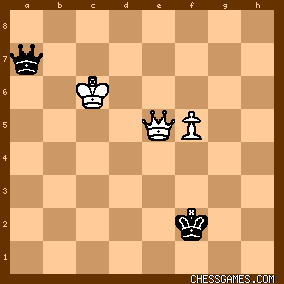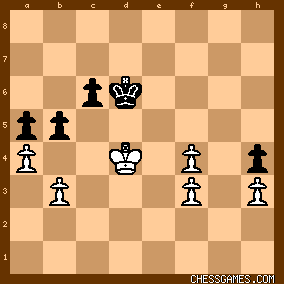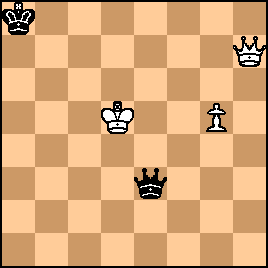| Aug-02-09 | | whiteshark: Q: Isn't the final position a draw after <79...Qf1>? A: No! <80.___> |
|
| Aug-31-12 | | master of defence: <whiteshark> It´s a win for white after 80.Qd2!(only move to win) threatening mate, and black must give up your queen to don´t lose immediately. |
|
| Jul-10-15 | | SpiritedReposte: That is like a composed problem! Wasn't aware of this motif. |
|
Jul-10-15
 | | OhioChessFan: I decided to have a look with an end game database. Shockingly, Black's losing move was his 59th move:
click for larger viewBlack to play. Qa6? loses in 54 moves. Kf3 is the only move to hold a draw. Anyone who can explain why is in a universe of their own. |
|
Jul-10-15
 | | OhioChessFan: FWIW 79...Qf1 80. Qd4 also wins. |
|
Oct-08-17
 | | offramp: This game is from the 2001 White Nights Tournament in St Petersburg which was originally open only to single ladies. Grachev and Savosto wrote letter to Vladimir Putin saying how unfair and exclusive that was, and Putin stepped in immediately. He made a pronouncement that ALL chess tournaments must be open to ALL members of the human race regardless of sex, marital status, race, colour, religious creed, national origin, ancestry, sex, sexual orientation, age, genetic information, military service, or chess playing ability or disability. And thus it has been ever since.
HAIL PUTIN!😂 |
|
Oct-08-17
 | | offramp: White missed a good move.

click for larger view
35. b4!! wins quickly. |
|
Oct-08-17
 | | FSR: What is the meaning of this pun? |
|
| Oct-08-17 | | rogl: In the end it's only the ladies left( if you leave out the kings) |
|
| Oct-08-17 | | Ratt Boy: <OhioChessFan: FWIW 79...Qf1 80. Qd4 also wins.> I agree. 79...♕f1 80.♕d4+, ♔h1 81.♕h4+, ♕h3 82.♕xh3+ & mates next. |
|
| Oct-08-17 | | paavoh: @FSR: it is a Beyonce song, not that it explains the pun. |
|
Oct-08-17
 | | offramp: <paavoh: @FSR: it is a Beyonce song, not that it explains the pun.> Um, excuse me.. but i think i rather fully explained it in my first post.. or are you ignoring me owing to my sex, marital status, race, colour, religious creed, national origin, ancestry, sex, sexual orientation, age, genetic information, military service, or chess playing ability or disability? |
|
| Oct-08-17 | | Strelets: Queen endings seem to be the most difficult to play correctly. Does anyone have a book to recommend on the topic? |
|
| Oct-08-17 | | TrczkWszczinsk: Thanks, offramp, for this excellent find. It is very instructive! |
|
Oct-08-17
 | | fm avari viraf: After 79...Qf1 the simplest way to win is 80.Qd2 & mates in 2 |
|
| Oct-08-17 | | Cheapo by the Dozen: Unless I'm missing something, 80 Qd4+ also leads quickly to mate. |
|
| Oct-08-17 | | TheBish: Actually, after 79...Qf1, 80. Qd2 is not a mate in 2, as Black ditches the queen to prolong mate, i.e. 80...Qh3+. Still quicker than the direct checking method with 80...Qd4+ (mate in 4 as opposed to mate in 5). But in an OTB game, most of us would take the forced mate with a series of checks! |
|
| Oct-08-17 | | TheBish: <offramp: White missed a good move. 35. b4!! wins quickly.> Good call! Those pawn breakthroughs are easy to miss. Even the analysis board engine misses that win, even after making the move! Only after entering several more moves does it evaluate a clear win. I think many GMs would miss 35. b4!, because when you already have a simple technical win, you are just looking to convert it, not usually looking for tactics or complications. |
|
| Oct-08-17 | | RandomVisitor: <Strelets: Queen endings seem to be the most difficult to play correctly. Does anyone have a book to recommend on the topic?> Pulling out my copy of Basic Chess Endings we find: II Queen and Pawn Endings
A. Queen and Pawn vs. Queen
This is a draw unless White has a bishop-pawn or center-pawn on the seventh supported by the king. As a rule, it is best for Black to have his king as far from the pawn as possible, unless, of course, it can occupy a square in front of the pawn, in which case the game is a hopeless draw. <In general, it is impossible to advance the pawn very far. Black keeps checking until he runs out of checks and then pins the pawn.> In view of the terrific number of possible positions, precise analysis can be done only by computer. In practice, however, it is usually found that the pawn can be held back. ...But even with the king at a distance from the pawn, <there are some special winning positions>. One of these, which also shows that there are other cases besides those already mentioned where queen vs. queen with no pawns may win is [example cited here where White is able to force a queen exchange and the Black king is too far from the passed pawn] ...To sum up: Queen and pawn vs. queen wins only with bishop-pawn or center-pawn on the seventh. Black's king should be as far as possible from the pawn. A bad king position may cost Black the game in otherwise drawn positions. |
|
| Oct-09-17 | | kevin86: This turned out not to be as simple as it looked. |
|
| Oct-09-17 | | RandomVisitor: 33.f5, 33.Ke4, 33.h4 all win, but not the move played, 33.Kd4... |
|
| Oct-11-17 | | paavoh: <Um, excuse me.. but i think i rather fully explained it...> Sorry <offramp>, no offense or ignoring intended. Your true story and the pun context seemed tangential at best, but that's my poor imagination, not you :-) |
|
Feb-16-22
 | | Sally Simpson: The idea of saccing the pawn with a check and hitting back with a discovered check reminds me of Bernard Horwitz study. (white to play and win)
click for larger view1. Qe4 Qxg5+ 2. Kc6

click for larger viewAnd White's mates in a few moves from here, the critical lines being any BQ check is met with a discovered check. |
|





